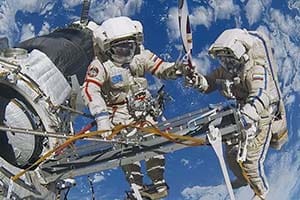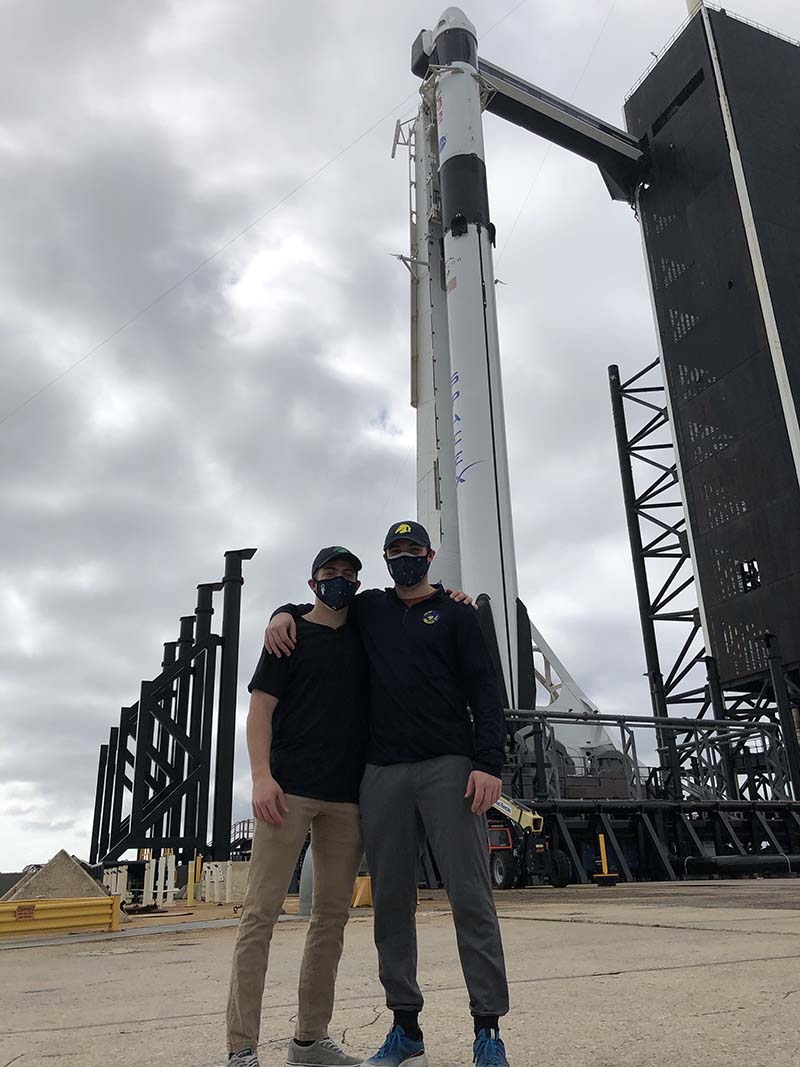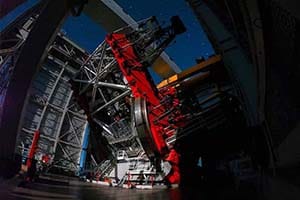
At 6:03 p.m., Nov. 21, Notre Dame sophomore Lucas Hopkins could look to the sky from his family’s home southeast of Houston and watch his father fly overhead.
Just four minutes later, his dad, U.S. Air Force Col. Michael Hopkins, flew over the Notre Dame campus.
Time flies when you’re speeding 250 miles above planet Earth at 17,500 miles per hour aboard the International Space Station (ISS).
Six days earlier, Lucas was with his mom Julie, older brother Ryan and other family members and friends watching his dad lift off to the ISS from the Kennedy Space Center as commander of the Crew-1 SpaceX Crew Dragon.
“We were at a building about two miles away (from Launch Complex 39A), and 15 minutes before launch we went up on the roof,” Lucas said. “We were all tracking our heart rates and they shot up as it got closer.

“As soon as the rocket lights up, it’s a combination of nervousness and excitement. I mean, my dad is strapped to the top of this rocket. It’s an insane mix of emotions, but such a good feeling. I felt confident after about three minutes (into the flight), but my mom was pretty nervous throughout. Once they were about seven minutes in, everything looked good.”
Lucas almost didn’t make it to Cape Canaveral, but thanks to his rector in Keough Hall, Rev. Brogan Ryan, C.S.C., and the staff at Coronavirus Response Unit (CRU), he got there — a little late but in time.
Originally scheduled to travel to Florida Nov. 8, a week before the launch, Lucas was waylaid after contact tracing put him into quarantine Nov. 4. Using the 4/7 protocol that Notre Dame developed in conjunction with the St. Joseph County Department of Health, CRU staff monitored Lucas closely and tested him on day four and day seven of his quarantine period. After testing negative on both days, he was cleared to leave quarantine and flew to Florida on Nov. 12, two days before the scheduled launch (which ended up being delayed one day to Sunday, Nov. 15).
Faculty members also played a helpful role in getting Lucas to liftoff, giving him excused absences and working with him on homework and scheduling finals.
“All of my professors were very understanding and thought it was very cool,” said Lucas, who is majoring in statistics in the College of Science with plans to minor in actuarial science and, possibly, some kind of business minor.
“As soon as the rocket lights up, it’s a combination of nervousness and excitement.” - Lucas Hopkins
He took one final exam online while in Florida, then flew back to Notre Dame on Nov. 16 for the rest of his finals. He returned home to Friendswood, Texas, on Nov. 20.
Mike Hopkins earned a bachelor’s degree in aerospace engineering from the University of Illinois, where he was captain of the football team, and a master’s degree, also in aerospace, from Stanford University. He served the Air Force in numerous capacities and locales before his selection to the astronaut corps. Lucas was born in Cold Lake, Alberta, Canada, where Mike was an exchange officer at the Canadian Flight Test Center. His assignments then took the family to Monterrey, California; Parma, Italy, outside Rome; and Virginia, where Mike served at the Pentagon in the Air Force Rapid Capabilities Office and as a special assistant to the vice chairman of the Joint Chiefs of Staff.
It took 12 years and four applications before Mike realized his dream of becoming an astronaut. In a commencement address in 2014 at his undergraduate alma mater he said: “I started applying to NASA’s astronaut training program in 1996. I was turned down for the 1998 class, for the 2000 class, and, again, for the 2004 class. I figured I’d just keep applying until I either made it or NASA told me, ‘Don’t bother.’ I finally was accepted into the 2009 class.”
Lucas remembers well how his father revealed his selection. While living in Virginia, the family toured the Smithsonian Institution’s National Air and Space Museum, which had astronaut teddy bears in the gift shop. Mike told the boys he would get them one if he was ever selected to the astronaut corps.
“We were at a restaurant and my dad pulled out the teddy bears,” Lucas said. “I was eight and didn’t quite get it at first. But then I understood after my brother said, ‘No, way!’”
This is Mike’s second long-duration mission to the ISS. He spent 166 days on station after launching from the Baikonur Cosmodrome in Kazakhstan Sept. 25, 2013, aboard a Russian Soyuz spacecraft.
Lucas was 12 at the time and remembers one especially different experience between then and now.
“We were with about 15 family members from others on the mission,” he said, “and they took all of us out to an open field to watch the launch. There, literally, were camels in the field behind us.”
On the 2013 mission, Mike completed 2,656 orbits of the Earth, traveled more than 70 million miles and, with fellow astronaut Rick Mastracchio, conducted two space walks totaling nearly 13 hours to make repairs to a degraded pump module. As with his previous stay on station, he is a flight engineer on the current mission, which will include a series of spacewalks, the arrival and departure of cargo freighters, a wide array of scientific experiments and maintenance on the space station.
Col. Hopkins will again command Crew-1 when it returns for a splashdown in the Atlantic Ocean off the east coast of Florida or in the Gulf of Mexico around May 1. That’s two weeks before Notre Dame’s final exams begin, so, if everything goes according to schedule, Lucas should be able to watch his father’s return from space without quite the academic challenges he faced at the end of this semester.
